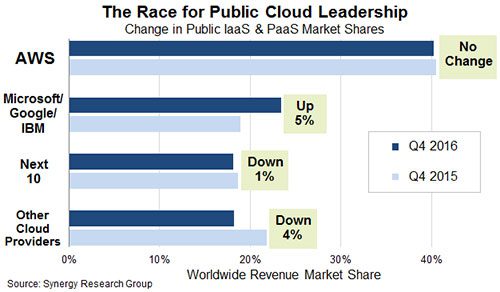Microsoft, Google and IBM are growing their respective clouds, but their gains are barely putting a dent in Amazon Web Services’ (AWS) leadership position.
In its analysis of worldwide public cloud services revenues for the fourth quarter of 2016, Synergy Research found that AWS sat comfortably at the top with just over 40 percent of the market, essentially unchanged from the prior year. Collectively Microsoft, Google and IBM saw their cloud sales rise by 5 percent year-over-year for a 23-percent slice of the market.
Cloud Storage and Backup Benefits
Protecting your company’s data is critical. Cloud storage with automated backup is scalable, flexible and provides peace of mind. Cobalt Iron’s enterprise-grade backup and recovery solution is known for its hands-free automation and reliability, at a lower cost. Cloud backup that just works.
The next 10 cloud providers, a bunch that includes Oracle and Alibaba, slipped 1 percentage point in Q4. The rest, a collection of small-to-midsized cloud companies, shed 4 points to settle at an 18-percent share of the market.
In total, Synergy Research estimates that the world’s public cloud infrastructure providers, a category that includes infrastructure-as-a-service (IaaS) and platform-as-a-service (PaaS), crossed the $7 billion-dollar mark in quarterly revenues in Q4 2016. Adding private cloud to the mix bumps that figure to an estimated $9 billion.
“AWS remains in a field of its own and is maintaining a steady market share in a rapidly growing public cloud market,” John Dinsdale, chief analyst and research director at Synergy Research Group, told Datamation. “While Microsoft, Google and IBM are growing at impressive rates and gaining market share, their gains are coming at the expense of smaller cloud providers and not AWS. There are good reasons why AWS is staying at the forefront of the market, and serious challengers need to follow the AWS example.”
Those reasons, according to Dinsdale, include credibility among large enterprises, a growing roster of cloud services and continued investments by Amazon in its cloud empire. Just this week, AWS officially launched its new Cloud Directory service for organizations seeking a flexible and scalable way of using, storing and managing hierarchical data.
“Amazon Cloud Directory is a managed service; you don’t need to think about installing or patching software, managing servers, or scaling any storage or compute infrastructure,” wrote Jeff Barr, chief evangelist at AWS, in a Jan. 26 announcement. “You simply define the schemas, create a directory, and then populate your directory by making calls to the Cloud Directory API [application programming interface]. This API is designed for speed and for scale, with efficient, batch-based read and write functions.”
Pedro Hernandez is a contributing editor at Datamation. Follow him on Twitter @ecoINSITE.



